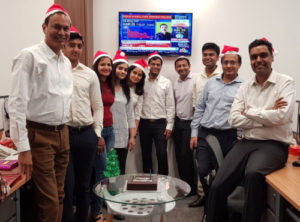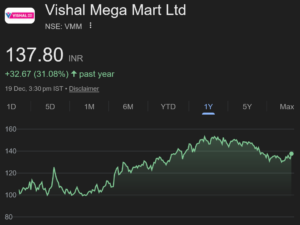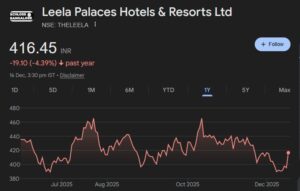
Bajaj Electricals

Outlook: Whilst the FY13 outlook for the E&P business of Bajaj Electricals is sluggish (as the existing order book consists of many projects which have seen cost over runs), in FY14 the business is likely to see a significant improvement in margins and cash flows as management is confident of completing the majority of its troubled sites in 2HFY13.
With regards to the non-E&P business, management is confident of recording an overall revenue growth of 15 per cent underpinned by a healthy 25 per cent growth in the domestic appliances segment.
Valuation: Bajaj Electricals trades at 13.4x FY13 P/E, 2.4x FY13 book value and 8.9x FY13EV/EBITDA. Compared to peers’ – Havells and V-Guard – Bajaj Electricals trades at a discount of 31 per cent, 24 per cent and 56 per cent based on P/E, EV/EBITDA and P/B respectively. Compared to its four year average, Bajaj Electricals trades at a premium of 6 per cent and 25 per cent based on FY13 P/E and EV/EBITDA multiples respectively.
Balkrishna Industries
Outlook: Balkrishna Industries is expected to record revenue growth of 27 per cent YoY, EBITDA margin of 19.1 per cent and net earnings growth of 26 per cent in FY13. The depreciation that has taken place in H1 FY13 in the rupee (relative to both US$ and Euro) is expected to favourably impact realisation and margins in the forthcoming quarters. However, on the negative side, Balkrishna Industries’ order book witnessed a decline of around 20 per cent QoQ in volume terms and around 18 per cent in value terms in 1QFY13.
Valuation: Balkrishna Industries earns significantly better RoICs v/s peers due to its much better margin profile. The DCF model values Balkrishna Industries’ core OHT business at Rs 315/share, implying 11 per cent upside and 8.5x FY14 net earnings (a premium of 10% to Apollo Tyres). On a cross cycle P/E comparison, Balkrishna Industries is trading at a premium of 14% to the average multiple of the company over last six years.
Elgi Equipments
Outlook: Elgi Equipments’ consensus estimates as per Bloomberg imply growth of 10 per cent and 13 per cent in sales and PAT respectively in FY13. The Elgi Equipments management has indicated that sales growth will be around 15 per cent and that the firm will seek to maintain the EBITDA margin in the range of 10-11 per cent.
Valuation: Elgi Equipments trades at 15x FY13 P/E, 2.8x FY13 book value and 9.3x FY13 EV/EBITDA. Compared to its own four year averages, these estimates are at a 33 per cent premium, 18 per cent premium and 42 per cent premium respectively. Peers – Ingersoll Rand (India) and Atlas Copco – trade at 16x FY13 P/E and 12.3x FY13 P/E respectively.
Greaves Cotton
Outlook: Whilst the outlook for FY13 on revenues and earnings continue to remain muted Greaves Cotton is expected to announce entry into a new segment (possibly super compact cars) which could rerate the stock.
The super compact car segment is growing at a fast pace with volumes of 187,026 vehicles (compared to Greaves’ current volumes of ~0.4mn engines). On the genset and the construction equipment portfolio, an uptick from FY14 onwards is expected following a pick-up in investment growth (measured by Gross Fixed Capital Formation).
Valuation: Greaves Cotton’s DCF assumes a WACC of 14 per cent and terminal growth of 3 per cent which translates into a valuation of Rs 94 implying 25 per cent upside. At CMP, Greaves Cotton stock trades at 11.3x FY14 earnings which is a discount of 34 per cent compared to Cummins. Such a huge discount is unjustified given a similar earnings profile and return ratios. Cummins and Greaves Cotton have earnings growth of 17 per cent and 13 per cent in FY14 respectively and similar ROCE of 21 per cent.
Heidelberg Cements
Outlook: The doubling of capacity and the resultant operating leverage in terms of cost savings would enable Heidelberg Cements to improve its margins and profitability. Stable cement prices and high utilisation in the Central region is also likely to benefit Heidelberg Cements.
With Heidelberg’s current net debt of Rs 7.6 billion is likely to have peaked out and with no major capex plans for CY13, Heidelberg Cements will generate positive FCF. Consensus estimates indicate that Heidelberg’s EBITDA and EPS will grow at a CAGR of 107 per cent and 85 per cent respectively over CY11-13 resulting in a sharp jump in return ratios going forward.
Valuation: Heidelberg is currently trading at 6.9x 1-year forward EV/EBITDA on consensus EBITDA estimates. Whilst on EV/tonne the stock is trading at a US$55, a 39 per cent premium to its 5-year average, on 1-year forward EV/EBITDA, the stock is trading at an 11 per cent premium to its 5-year average. The return ratios are expected to improve from here on. Expansions and cost rationlisation would lead to improvement in EBITDA/tonne.
ICRA
Outlook: Whilst FY12 revenues and profits of ICRA grew modestly by only 11-12 per cent, ICRA would be a disproportionate beneficiary of a pick-up in the investment cycle leading to increased credit off-take and more bond issuances by Indian corporates.
With operating leverage in the business model, PAT growth would be disproportionately higher than revenue growth.
Valuation: ICRA trades at 17.6x FY13E P/E and 15.6x FY14E P/E based on consensus estimates and is at 33 per cent discount respectively to its closest peer CRISIL on 1 year rolling forward PE ratio. Increased competition in the segment leading to pressure on growth and margins is the key risk to ICRA.
Info Edge
Outlook: For the rest of FY13, Info Edge
is expected to grow revenues strongly due to: (a) Healthy volume growth of 10-12 per cent YoY in core recruitment; and (b) Improving realizations due to price inflation and lower discounting as the economy improves.
Valuation: Assumptions point to 22 per cent FY12-14 EPS growth of Info Edge
supported by growth in real estate and operational leverage as more businesses break even. This makes the Info Edge shares look attractive even at 25xFY14 P/E and 17x FY14 EV/EBITDA. Info Edge’s SOTP based 3 stage DCF valuation points to Rs 423, implying 21 per cent upside and FY14 P/E of 30x.
Kirloskar Oil Engines
Outlook: In FY14, the manufacturing and capital goods sector growth is expected to pick up on the back of an improvement in investment growth measured by Gross Fixed Capital Formation (GFCF).
YoY growth in GFCF for FY14 is expected to increase to 6.1 per cent from 5.5 per cent earlier given the recent string of policy reforms unleashed by the Government and the likelihood of future policy reforms in H2 FY13.
Valuation: Kirloskar Oil Engines trades at 12.2x FY13 P/E, 2x FY13 book value and 7.4x FY13EV/EBITDA. Compared to peers’ (Cummins and Greaves Cotton), these estimates are at a 28%, 50% and 30% discount respectively.
Compared to its two year average (last five years data is not available as Kirloskar Oil Engines got demerged in FY10), Kirloskar Oil Engines trades at a premium of 11% on both FY13 P/E and EV/EBITDA multiples.
Motilal Oswal Financial Services
Outlook: The 1HFY13 profits for MOFS would continue to remain muted showing nearly 10 per cent de-growth on YoY basis. If going forward, cash market volumes on Indian exchanges remain at the levels seen in the second fortnight of Sep’12, robust revenue and PAT CAGR of 24 per cent and 34 per cent respectively between FY12-14 is expected.
Valuation: Given the cyclical nature of the business, earnings multiples of Motilal Oswal Financial Services are expected to expand. The DCF model assumes a cost of equity of 15.0 per cent and terminal growth of 5 per cent. This translates to a valuation of Rs 143 implying 32 per cent upside and a FY14 P/E multiple of 11.0x (in-line with its average multiple between FY10-12).
Sadbhav Engineering
Outlook: A recovery in earnings and returns from FY14 onwards with new assets becoming operational is expected. Whilst consolidated PAT won’t grow over FY12- FY14, as 55 per cent of Sadbhav’s invested equity becomes operational by FY13-end.
Operating cash flows are expected to grow at a 21 per cent CAGR, thereby, not only providing for debt servicing (interest expenses to grow 4x between FY12-14E to Rs 4.7bn) but also equity capital for under-construction assets.
Valuation: Sadbhav Engineering’s SOTP value of Rs 175 implies 2x FY14 book. The road asset portfolio valuation implies 1.8x FY13 for Sadbhav’s investment in SIPL (Rs 11.8bn). Sadbhav Engineering’s relatively rich valuation is justified given its more realistic EPS and BVPS vs peers’ inflated metrics & second rung management teams. Sadbhav Engineering’s DCF-based construction business valuation implies 7x FY13 EPS, a discount to most peers.
Supreme Industries
Outlook: For FY13E, Supreme Industries’ management expects revenue growth of 20-25 per cent and PAT growth ahead of 25 per cent, mainly driven by the increasing share of the Value-Added-Products.
Over FY12-16, Supreme will invest Rs 11 billion over FY12-17 for near doubling of its capacities (more in pipes & industrial products. Alongside capacity and reach expansion, Supreme is targeting raising VAP revenue share to 35 per cent.
Valuation: Supreme Industries’ stock is currently trading at 13X FY13 PE on consensus EPS of Rs 21/share. Whilst the valuations appear to be at all time high, the present valuation is not demanding given Supreme Industries’ long history of positive free cash flows, ~25% RoCEs and ~40% RoEs.
WABCO India
Outlook: Over the longer term, WABCO India has significant potential to increase the content per vehicle through the introduction of higher value products such as advanced braking systems such as anti-lock braking systems, electronic braking systems and lift control axle valve.
WABCO India is entering into newer segments such as driveline products (automated manual transmission systems).
Valuation: WABCO is trading at 15x one-year rolling forward EPS which is at a premium of 18 per cent to the four average P/E but at a discount of 16% to the peak P/E multiple commanded by it in the last four years. Compared to other auto OEMs, it trades in-line with Bharat Forge but at a discount of 25% to Bosch India’s multiple.







